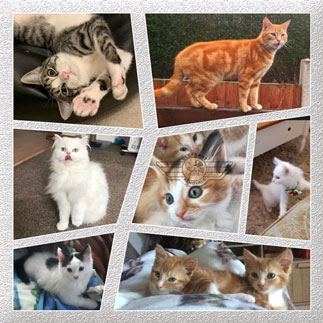
Moving House with a Cat
Best Guide on Moving Cats: Relocating house and travelling with a cat or Kitten to your new property can be stressful not only for us humans but also for animals too!
Whether you move for cats or moving home with a cat, our jaw-dropping ways on moving house with a cat with careful planning techniques will ensure moving cats to a new home is a hassle-free cat relocation for everyone.
How to Move with a Cat Tips
Cats are creatures of habit, so moving house with a cat can be stressful for them. They have strong bonds with their environment as they are territorial species. It is important for you to plan ahead on how to move with a cat, use our tips and hacks to make the transition of how to move house with a cat easier.
Elephant Removals has nearly 2 decades of experience as a London Removals Company. We have moved just about everything you can imagine within London or across the UK, we have stories that could fill one of our removal vans.
Moving Cats to a New Home
- Before the removal van arrives, it is advisable to place your cat in one room, the bedroom would be a good option.
- Put the cat carrier, cat bed, food bowl, water bowl and litter tray in the room and ensure the door and windows remain shut. Place a notice on the door so that removal men and family know that this door should be kept shut.
- When all other rooms have been emptied, the contents of the room can be placed in the van last. Before the furniture is removed your cat should be placed in the cat carrier and put safely in the car to make the journey to the new home.
- If it is a long journey you may want to stop and offer water or a chance to use a cat tray, although most cats will not be interested.
- Once you arrive at your new home, the bedroom furniture should be at the back of the lorry or van and therefore the first to be installed in the new home.
- Once the room is ready your cat can be placed inside with his bed, food bowl, water bowl and litter tray and the door shut. If possible, a family member can sit in the room with your cat for a while as your cat explores.
- Once the removal has been completed your cat can be allowed to investigate the rest of the house, one room at a time if there are any signs of anxiety.
- It is important to remain as calm as possible to signal to your cat that it is a safe environment.
- Ensure that all external doors and windows are shut.
- Do not allow your cat unsupervised access to the kitchen or utility room as particularly nervous cats will try and hide in narrow gaps behind the appliances.
Moving House with an Outdoor Cat
It is best to be prepared when you moving house with an outdoor cat. These simple steps could help you find your cat if it does go missing.
- Check your cat’s microchip details are all up to date. A quick call to the microchip provider to confirm they have your current and new contact details could make all the difference of becoming reunited if your cat goes missing.
- Make sure that you're up to date house and mobile number is on your cat’s collar.
- This may sound dramatic, but it is always better to be safe than sorry! Prepare a lost cat file with recent photos, description, names of local rescues etc. Then if your cat does become lost, at least you have everything you need to make lost posters and the numbers you need to get the word out.
Moving House with an Indoor Cat
- If you still live in the same area your cat may try to return to your old home. It would be a good idea to speak to the new owners and ask them not to feed your cat! Or allow your cat back into your old house. If you had an electric cat flap, it would be worth changing your cat’s collar, otherwise, your cat could easily sneak back in! You may also have to be prepared to go back to your old house to retrieve your cat!
- It is a good idea to sprinkle some of your cats used litter around the perimeter of your new garden. This will make your garden smell familiar. It will also make neighbouring cats aware that there is a new cat in the area! Chase away any cats if you see them in your garden, your cat will need all the help it can get to establish its territory as the new cat in the area.
- When you introduce your cat to their new garden and area outside, keep the outings short and stay with them. It is important not to carry your cat outside, allow it to decide if it wants to explore. The best time to do this is to let them out just before feeding them. Let your cat explore for a few minutes, then entice your cat back inside, by shaking its food or calling them as you would usually do at mealtimes. If your cat is used to a harness then it may be useful to walk it around the garden on a lead. The aim of this is to make your new home the centre of your cat's territory, which is the source of food and shelter.
Moving an older Cat to a new Home
Nothing is impossible so as moving an older cat to a new home, being a little nervous and sad is normal. Give them time, comfort and space with stuff he your sensitive cat loves and you’ll notice that it is okay to move a senior cat. You may consult a veterinarian or Veterinary Behaviourists for any special needs.
How long to keep Cats inside after Moving
As a rule of thumb on how long to keep a cat in after moving house, most people would say 2 weeks but this depends on your cat. If your cat is very confident and you can see that it is becoming frustrated indoors then you could let them go out on their own. If on the other hand, your cat is still quite nervous it would be advisable to keep them indoors for long. It is important that your cat feels comfortable as it begins to get used to its territory.
How to Settle a Cat After Moving House
The best way on how to settle a cat into a new home after travelling with your cat or cat transportation, do remember that every cat has their own character. It could take 1 week, 2 weeks and, in some cases, months before your cat can be allowed outside unattended. You are the cat owner and you are the best person to judge when the right time is for your cat to go out on their own. Your cat will come to love their new home in their own time.
Do Cats Get Lost when you Move?
The first question would be 'Do kittens run away?' There is no way of asking your cat ‘have you ever thought of running away?’ Cats running away is a common issue. When a cat goes missing, remember, there are individuals in every area who are willing to help. If they’ve found a stray cat, make it easy for them to locate the owner, so spread the word.
Will my Lost Cat come Home by itself?
If you’ve been treating an indoor cat well, perhaps several hours, whilst some cats take a few days to reach their threshold. An outdoor cat can take some days (typically 10-12 days) before cats break their cover.
How to Keep an Outdoor Cat from Running Away
The best way on how to stop your cat from running away when it is moved, is to use smell deterrents to keep them away from certain areas. Arranging an enclosure in the garden where kittens can play outdoors in safety removes the chance of them being lost or causing injuries. And especially during the initial weeks, give your pets high-quality food that your particular cat loves.
How to Find Lost Cat
Can cats get lost? Yes, for an indoor or an outdoor lost cat outside without a tracker or microchip, the best tip on how to find a missing cat is bearing in mind that they've got territoriality related behaviour and won't go too far so quickly. They tend to increase their range quite slowly after studying the area bit by bit. Hence, begin the search from nearby, seek neighbours help and check their garden’s hidden spots and bushes whilst shaking treats. You may circulate the news via social neighbourhood app platforms. You can also print posters and distribute leaflets near and not too far.
Moving House with a Cat
We hope the tips for moving house with a cat on feline would suffice, should you wish to send us your feedback on moving with cats, you are most welcome. For more info on moving house with old cats, Moving House with a Dog tips or any more info on pet relocation, please contact us. If you liked this content, don't forget to share with your loved ones by clicking the share button.

